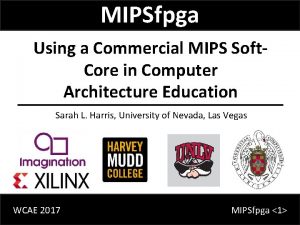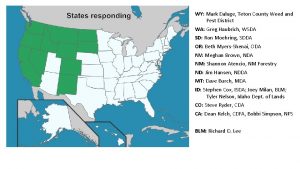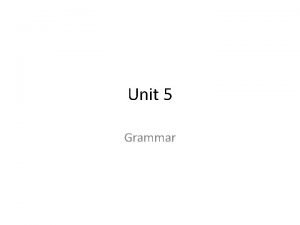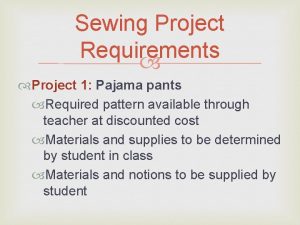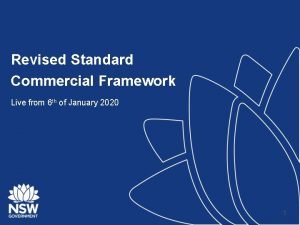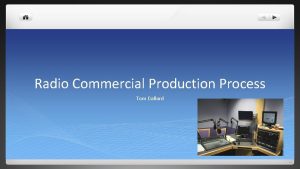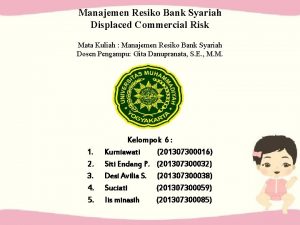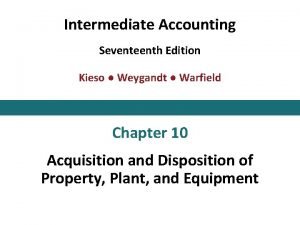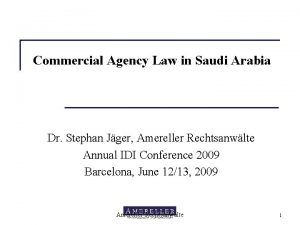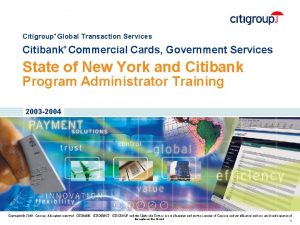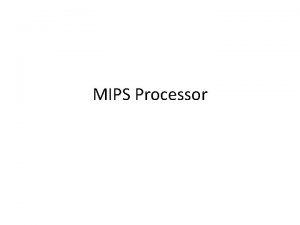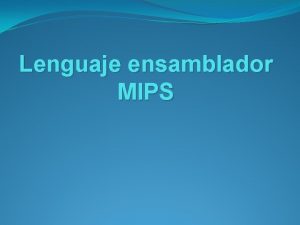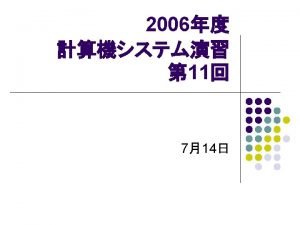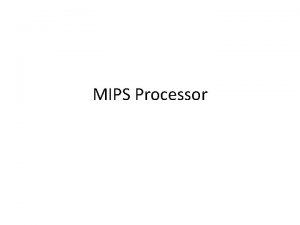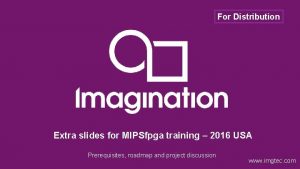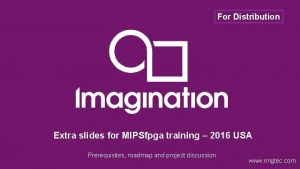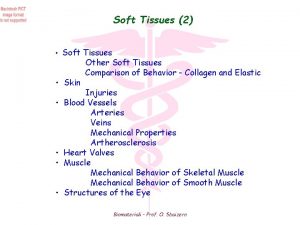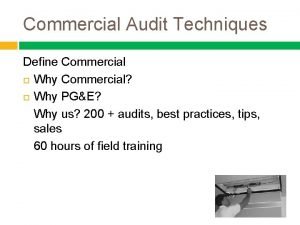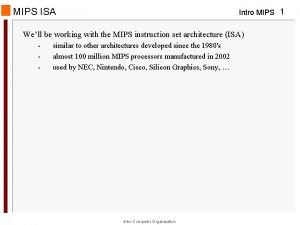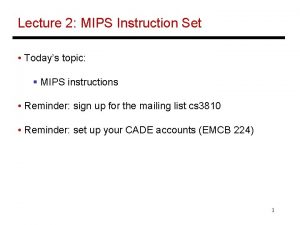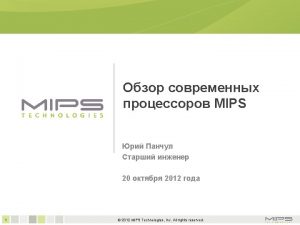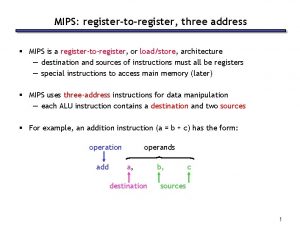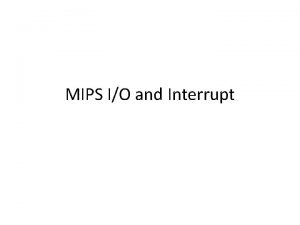MIPSfpga Using a Commercial MIPS Soft Core in



































![MIPSfpga Interfaces: AHB-Lite Signal Name HADDR[31: 0] HRDATA[31: 0] HWDATA[31: 0] Description Address bus MIPSfpga Interfaces: AHB-Lite Signal Name HADDR[31: 0] HRDATA[31: 0] HWDATA[31: 0] Description Address bus](https://slidetodoc.com/presentation_image/3ae5d05f6cb51edd3dd77d9c6e2f09f5/image-36.jpg)



![Memory-Mapped I/O Signal Name IO_LEDR[15: 0] IO_Switch[15: 0] IO_PB[4: 0] WCAE 2017 Virtual Address Memory-Mapped I/O Signal Name IO_LEDR[15: 0] IO_Switch[15: 0] IO_PB[4: 0] WCAE 2017 Virtual Address](https://slidetodoc.com/presentation_image/3ae5d05f6cb51edd3dd77d9c6e2f09f5/image-40.jpg)
![Memory-Mapped I/O Signal Name IO_LEDR[15: 0] IO_Switch[15: 0] IO_PB[4: 0] Virtual Address 0 xbf Memory-Mapped I/O Signal Name IO_LEDR[15: 0] IO_Switch[15: 0] IO_PB[4: 0] Virtual Address 0 xbf](https://slidetodoc.com/presentation_image/3ae5d05f6cb51edd3dd77d9c6e2f09f5/image-41.jpg)
![Memory-Mapped I/O Signal Name IO_LEDR[15: 0] IO_Switch[15: 0] IO_PB[4: 0] Virtual Address 0 xbf Memory-Mapped I/O Signal Name IO_LEDR[15: 0] IO_Switch[15: 0] IO_PB[4: 0] Virtual Address 0 xbf](https://slidetodoc.com/presentation_image/3ae5d05f6cb51edd3dd77d9c6e2f09f5/image-42.jpg)









- Slides: 51

MIPSfpga Using a Commercial MIPS Soft. Core in Computer Architecture Education Sarah L. Harris, University of Nevada, Las Vegas WCAE 2017 MIPSfpga <1>

Overview • • • Introduction MIPSfpga Overview Labs Example Courses and Applications Conclusion WCAE 2017 MIPSfpga <2>

Introduction • What is MIPSfpga? – MIPSfpga is an unobfuscated soft-core commercial MIPS processor available from Imagination Technologies for academic use. • MIPSfpga supporting material is provided in three packages: – MIPSfpga Getting Started Guide – MIPSfpga Labs – MIPSfpga So. C WCAE 2017 MIPSfpga <3>

MIPSfpga Materials • MIPSfpga Getting Started Guide – Overall MIPSfpga system, setup, and tools – Verilog files for the MIPSfpga core and system • MIPSfpga Labs – 25 hands-on labs for experimenting with, analyzing, and modifying the MIPSfpga system • MIPSfpga So. C – MIPSfpga as the core of a system-on-chip that runs Linux WCAE 2017 MIPSfpga <4>

MIPSfpga System MIPSfpga Core • Soft-core available in Verilog • System modules available in Verilog and VHDL WCAE 2017 MIPSfpga <5>

MIPSfpga: micro. Aptiv Core • Commercial micro. Aptiv core – – – 5 -stage pipeline Set-associative I & D caches MMU (memory management unit) with TLB Performance counters No DSP, Coprocessor 2, or shadow registers Interfaces: • AHB-Lite bus • EJTAG programmer/debugger • Cor. Extend for user-defined instructions WCAE 2017 MIPSfpga <6>

How to Run Programs on MIPSfpga? • In Simulation: – Model. Sim – Vivado built-in simulator • In Hardware: – Load program into memory: • at synthesis • using EJTAG interface (using Bus Blaster Probe) • using UART interface (i. e. , using Nexys 4 DDR’s existing programming cable or USB-UART FTDI board) WCAE 2017 MIPSfpga <7>

FPGA boards • Support for Nexys 4 DDR and DE 2 -115 boards • Instructions on how to port it to other FPGA boards (end of Lab 1) Nexys 4 DDR WCAE 2017 DE 2 -115 MIPSfpga <8>

System setup: Nexys 4 DDR + Bus. Blaster To USB port Nexys 4 DDR Board To USB port Bus Blaster Probe WCAE 2017 MIPSfpga <9>

Overview • • • Introduction MIPSfpga Overview Labs Example Courses and Applications Conclusion WCAE 2017 MIPSfpga <10>

MIPSfpga Labs • Hands-on learning in areas including: – – – – – System-on-chip (So. C) design Assembly language and C programming Instruction set architectures (ISAs) Design with hardware description languages (HDLs) Computer architecture Memory systems Memory-mapped I/O and interfacing with peripherals Interrupts Performance Counters WCAE 2017 MIPSfpga <11>

MIPSfpga Labs • Organized into four sections: – – Intro (Labs 1 -4) I/O (Labs 5 -13) Core (Labs 14 -19) Memory (Labs 20 -25) WCAE 2017 MIPSfpga <12>

MIPSfpga Labs Section Intro I/O WCAE 2017 Lab # Lab Name 1 Vivado project for MIPSfpga 2 C programming on MIPSfpga 3 Assembly programming 4 More programming practice (optional) 5 7 -segment displays 6 Reaction timer 7 Audio 8/9 SPI light sensor / LCD 10 Interrupts 11 Direct memory access (DMA) 12 DES encryption 13 Performance counters MIPSfpga <13>

MIPSfpga Labs Section Core Memory WCAE 2017 Lab # Lab Name 14 Instruction flow: ADD 15 Instruction flow: AND 16 Instruction flow: LW 17 Instruction flow: BEQ 18 Hazard logic 19 Cor. Extend: Adding user-defined instructions 20 Basic caching 21 Cache structure 22 Cache controller: Hit & miss management 23 Cache controller: Content management 24 Cache controller: Store and fill buffers 25 Scratchpad RAM MIPSfpga <14>

Overview • • • Introduction MIPSfpga Overview Labs Example Courses and Applications Conclusion WCAE 2017 MIPSfpga <15>

Example Courses and Applications • Course 1: 4 th year Integrated Systems Architecture Course • Course 2: 4 th year/Master’s level Processor and I/O Systems Lab • Hackathon MIPSfpga is best used after learning the basics of Digital Design, HDLs, and Computer Architecture. WCAE 2017 MIPSfpga <16>

Ex. 1: Systems Architecture Course • At UCM (Universidad Complutense de Madrid) 2017 • Student background – Digital & HDL design (VHDL) – Computer Organization (MIPS ISA, single/multicycle processors, I/O systems) – Programming (C++) WCAE 2017 MIPSfpga <17>

Course Contents • Module 1: – Review: MIPS ISA, single/multi-cycle processors, I/O systems • Module 2: – Pipelined processors • Module 3: – Caches • Module 4: – So. C and embedded system design WCAE 2017 MIPSfpga <18>

Course Materials • Textbook: – Digital Design and Computer Architecture, 2 nd Edition (Harris & Harris, Elsevier © 2012) • Slides: – Extended versions of the slides provided with the book and with MIPSfpga Labs • Labs: – MIPSfpga materials (MIPSfpga Labs and MIPSfpga So. C) • Exercises: – Worksheets adapted from textbook and labs WCAE 2017 MIPSfpga <19>

Course Schedule • Lectures: 24 1. 5 -hour lessons, 2 per week • Lab sessions 12 2 -hour sessions, 1 per week – Module 1: MIPS ISA & Hardware (5 weeks) • Install MIPSfpga tools and build MIPSfpga in Vivado (MIPS GSG & Lab 1) • Review MIPS ISA: assembly & C programming (Labs 2 -4) • Review: I/O Systems (Lab 5: Add 7 -segment displays) – Module 2: Pipelined Processor (3 weeks) • Labs 13 -18 (ADD, AND, LW, BEQ instruction flow, Hazard Unit) – Module 3: Cache Hierarchy (3 weeks) • Labs 22 A and 22 B (Cache hits, Cache misses) – Module 4: So. C and Embedded System Design (1 week) • MIPSfpga So. C Starter Tutorial WCAE 2017 MIPSfpga <20>

Ex. 2: Processor & I/O Systems Lab • At TUD (Technical University of Darmstadt, Germany) in 2016 • Student background – Digital & HDL design (VHDL) – Computer Organization (MIPS ISA, single/multicycle processors, I/O systems) – Programming WCAE 2017 MIPSfpga <21>

Course Materials • Textbook: – Digital Design and Computer Architecture, 2 nd Edition (Harris & Harris, Elsevier © 2012) • Slides: – Extended versions of the slides provided with the book and MIPSfpga Labs • Labs: – Textbook and MIPSfpga Labs • Lab kit cost: $15 + Nexys 4 DDR board ($159) & Bus Blaster probe ($50). Total: $234 WCAE 2017 MIPSfpga <22>

Course Contents Lab MIPSfpga Lab # Description Duration 1 Lab 3 MIPS Assembly Programming (using simulator) 1 week 2 Lab from book MIPS Single-Cycle Processor 1 week 3 Lab from book MIPS Pipelined Processor 2 weeks 4 Lab 1 MIPSfpga Tutorial 1 week 5 Lab 7 MIPSfpga Memory-mapped I/O: Buzzer 1 week 6 Lab 9 MIPSfpga Memory-mapped I/O: LCD 2 weeks 7 Lab 11 MIPSfpga DMA Engine 2 weeks 8 Lab 12 MIPSfpga DES Encryption with DMA 2 weeks WCAE 2017 MIPSfpga <23>

Ex. 3: Hackathon • Seminars in Russia, Ukraine and Kazakhstan in 2015/2016 • MIPSfpga integrated into courses / labs • Culminated in Hackathon where students interfaced MIPSfpga to peripherals using SPI, I 2 C, etc. (see MIPSfpga I/O Labs) http: //store. digilentinc. com/pmod-expansion-modules/pmod-boards/ WCAE 2017 MIPSfpga <24>

Overview • • • Introduction MIPSfpga Overview Labs Example Courses and Applications Conclusion WCAE 2017 MIPSfpga <25>

MIPSfpga Comparisons Name Comparisons Nios, Nios II, Microblaze, Cortex M 0 Design Start + Soft-core - Obfuscated Open. SPARC, Leon + Soft-core + Open-source - Few teaching materials - ISA not commonly used in academia RISC-V, open. RISC + Soft-core + Open-source - Not a commercial core - Few teaching materials MIPSfpga: WCAE 2017 + Unobfuscated soft-core + Commercial core (e. g. , used in Microchip’s PIC 32 MZ) + Commonly taught ISA in academia + Robust teaching materials MIPSfpga <26>

Conclusions • MIPSfpga bridges the gap between toy processors and industry-level processors. • MIPSfpga is an excellent resource for courses in: – Digital design, computer architecture, embedded systems, Memory systems, VLSI design, So. C design • MIPSfpga offers robust teaching materials best used in upper-division undergraduate or master’s -level courses. WCAE 2017 MIPSfpga <27>

MIPSfpga Materials & Support • MIPSfpga materials available on the Imagination University Program Website under Teaching Materials: http: //community. imgtec. com/university-registration • MIPSfpga Forum (technical support): http: //community. imgtec. com/forums/cat/mips-insider/mipsfpga/ • Other Forums – MIPS Tech Support (general questions): http: //community. imgtec. com/forums/cat/mips-insider/ – Imagination University Programme (curriculum discussions, IUP questions, etc. – no tech support): http: //community. imgtec. com/forums/cat/university/ WCAE 2017 MIPSfpga <28>

Acknowledgements • • • Robert Owen Sarah Harris Daniel Chaver-Martinez David Money Harris Yuri Panchul Bruce Ableidinger Enrique Sedano Zubair Kakakhel Kent Brinkley Chuck Swartley Akhilesh Sandeep Thakur Christian White WCAE 2017 • • • Sean Raby Rick Leatherman Matthew Fortune Munir Hasan Sachin Sundar Michael Alexander Sam Bobrowicz Cathal Mc. Cabe Roy Kravitz Alexey Pereverzev Nicholas Beser • • • Larissa Swanland Clint Cole Students and faculty at UCL Ian Oliver Steve Kromer Parimal Patel Jason Wong Zhe Yang Professor Dai Zhongzheng (Jason) Wang Bin He Dennis Pinto MIPSfpga <29>

Thank you! Any questions? WCAE 2017 MIPSfpga <30>

Extra Slides WCAE 2017 MIPSfpga <31>

MIPSfpga Core WCAE 2017 MIPSfpga <32>

MIPSfpga 5 -Stage Pipeline # Stage Name 1 2 I E 3 4 M A 5 W WCAE 2017 Description Instruction Fetch Instruction Execution Fetch operands from RF & perform ALU operation Memory Access Memory Align data to word boundary Writeback Write result to RF MIPSfpga <33>

MIPSfpga Memory Map • 32 -bit virtual memory space (0 x 0000 – 0 x. FFFF), broken up into different segments • On reset, processor begins in kernel mode and jumps to the reset vector at address 0 x. BFC 00000 (mapped to physical address 0 x 1 FC 00000) WCAE 2017 MIPSfpga <34>

MIPSfpga System: Physical Memory Boot Code: Code executed at startup (128 KB) User Code/Data (256 KB) WCAE 2017 MIPSfpga <35>
![MIPSfpga Interfaces AHBLite Signal Name HADDR31 0 HRDATA31 0 HWDATA31 0 Description Address bus MIPSfpga Interfaces: AHB-Lite Signal Name HADDR[31: 0] HRDATA[31: 0] HWDATA[31: 0] Description Address bus](https://slidetodoc.com/presentation_image/3ae5d05f6cb51edd3dd77d9c6e2f09f5/image-36.jpg)
MIPSfpga Interfaces: AHB-Lite Signal Name HADDR[31: 0] HRDATA[31: 0] HWDATA[31: 0] Description Address bus Read data bus Write data bus HWRITE HCLK Write enable Clock H: prefix for AHB-Lite Interface signals in Verilog files WCAE 2017 MIPSfpga <36>

AHB-Lite Memory / Peripherals WCAE 2017 MIPSfpga <37>

AHB-Lite Write Timing Cycle 1: Address and Write Enable (HADDR & HWRITE) Cycle 2: Write Data (HWDATA) WCAE 2017 MIPSfpga <38>

AHB-Lite Read Timing Cycle 1: Address (HADDR) (also, HWRITE = 0) Cycle 2: Read Data (HRDATA) WCAE 2017 MIPSfpga <39>
![MemoryMapped IO Signal Name IOLEDR15 0 IOSwitch15 0 IOPB4 0 WCAE 2017 Virtual Address Memory-Mapped I/O Signal Name IO_LEDR[15: 0] IO_Switch[15: 0] IO_PB[4: 0] WCAE 2017 Virtual Address](https://slidetodoc.com/presentation_image/3ae5d05f6cb51edd3dd77d9c6e2f09f5/image-40.jpg)
Memory-Mapped I/O Signal Name IO_LEDR[15: 0] IO_Switch[15: 0] IO_PB[4: 0] WCAE 2017 Virtual Address 0 xbf 800000 0 xbf 800008 0 xbf 80000 c Physical Address 0 x 1 f 800000 0 x 1 f 800008 0 x 1 f 80000 c MIPSfpga <40>
![MemoryMapped IO Signal Name IOLEDR15 0 IOSwitch15 0 IOPB4 0 Virtual Address 0 xbf Memory-Mapped I/O Signal Name IO_LEDR[15: 0] IO_Switch[15: 0] IO_PB[4: 0] Virtual Address 0 xbf](https://slidetodoc.com/presentation_image/3ae5d05f6cb51edd3dd77d9c6e2f09f5/image-41.jpg)
Memory-Mapped I/O Signal Name IO_LEDR[15: 0] IO_Switch[15: 0] IO_PB[4: 0] Virtual Address 0 xbf 800000 0 xbf 800008 0 xbf 80000 c Physical Address 0 x 1 f 800000 0 x 1 f 800008 0 x 1 f 80000 c • Write to 0 xbf 800000 writes to LEDs // Write 0 x 543 to LEDs addiu $7, $0, 0 x 543 # $7 = 0 x 543 lui $5, 0 xbf 80 # $5 = 0 xbf 800000 (LED address) sw $7, 0($5) # LEDs = 0 x 543 WCAE 2017 MIPSfpga <41>
![MemoryMapped IO Signal Name IOLEDR15 0 IOSwitch15 0 IOPB4 0 Virtual Address 0 xbf Memory-Mapped I/O Signal Name IO_LEDR[15: 0] IO_Switch[15: 0] IO_PB[4: 0] Virtual Address 0 xbf](https://slidetodoc.com/presentation_image/3ae5d05f6cb51edd3dd77d9c6e2f09f5/image-42.jpg)
Memory-Mapped I/O Signal Name IO_LEDR[15: 0] IO_Switch[15: 0] IO_PB[4: 0] Virtual Address 0 xbf 800000 0 xbf 800008 0 xbf 80000 c Physical Address 0 x 1 f 800000 0 x 1 f 800008 0 x 1 f 80000 c • Write to 0 xbf 800000 writes to LEDs • Read from 0 xbf 800008 reads value of switches // Read value of switches into $10 lui $5, 0 xbf 80 # $5 = 0 xbf 800000 lw $10, 8($5) # $10 = value of switches WCAE 2017 MIPSfpga <42>

Exampe Labs WCAE 2017 MIPSfpga <43>

Example: Lab 4 (Part 1) • Image Transformation: – Skeleton code – students complete in C – 2 extra exercises – students complete in MIPS assembly – Test/run lab on MIPSfpga WCAE 2017 MIPSfpga <44>

Example: Lab 13 (Part 2) MIPS Pipelined Processor from book WCAE 2017 MIPSfpga <45>

Example: Lab 13 (Part 2) micro. Aptiv pipelined processor (MIPSfpga) WCAE 2017 MIPSfpga <46>

Example: Lab 13 (Part 2) LUI ADDIU SUB ADDI Loop 1: BEQ LW ADDI B Out: LUI ADDIU SW WCAE 2017 $t 0, 0 x 8000 $t 0, test_array $t 1, $t 1 $t 3, $t 3 $t 4, $0, 1000 $t 3, $t 4, Out $t 5, 0($t 0) $t 1, $t 5 $t 0, 4 $t 3, 1 Loop 1 $t 3, 0 x 8000 $t 3, Addition $t 1, 0($t 3) • Analyze the data and control hazards: – Processor from the book – Micro. Aptiv • Determine CPI for the processor from the book • Determine CPI for micro. Aptiv and measure it • Reorder the code and repeat the exercise MIPSfpga <47>

Lab 14: Add Instruction WCAE 2017 MIPSfpga <48>

Example: Lab 22 -B: D$ Misses (Part 3) Goal: Analyze I$/D$ miss management • Theoretical explanation of D$ miss management • D$ miss simulations • Exercises: – Analyze a D$ hit – Determine the miss penalty – Code optimization techniques • Array enlargement and array merging • Loop interchange • Blocking WCAE 2017 MIPSfpga <49>

Example: MIPSfpga-So. C – Starter Tutorial Build a System On Chip based on micro. Aptiv core and Xilinx IP blocks WCAE 2017 MIPSfpga <50>

MIPSfpga-So. C – Starter Tutorial Run Linux and play with it 1. 2. 3. 4. 5. 6. 7. 8. Download the Bitstream Terminal Emulation – putty Run the bootram code Load Linux to memory via EJTAG Booting Linux Writing and Compiling a Program Reading the onboard temperature sensor via sysfs Accessing general-purpose I/Os via sysfs WCAE 2017 MIPSfpga <51>
 Soft core
Soft core Commercial and noncommercial food service operations
Commercial and noncommercial food service operations Soft iron core
Soft iron core The brittle, rocky outer layer of earth
The brittle, rocky outer layer of earth Inner core and outer core
Inner core and outer core What are the 3 main layers of the earth? *
What are the 3 main layers of the earth? * Core capabilities and core rigidities
Core capabilities and core rigidities Artists who model forms using soft pliable materials
Artists who model forms using soft pliable materials Using system.collections.generic
Using system.collections.generic Accumulator ac
Accumulator ac Rodent exterminator teton county
Rodent exterminator teton county Why mine data commercial viewpoint
Why mine data commercial viewpoint Almost as soon as the gorilla television commercial
Almost as soon as the gorilla television commercial Unit 27 commercial ice machines
Unit 27 commercial ice machines Commercial tourism meaning
Commercial tourism meaning Rockstar energy drink slogan
Rockstar energy drink slogan Pajama jeans commercial
Pajama jeans commercial Structure of commercial banks in india
Structure of commercial banks in india Commercial framework
Commercial framework Radio commercial production process
Radio commercial production process Why do ruffles have ridges?
Why do ruffles have ridges? Commercial substance
Commercial substance Medusa commercial song
Medusa commercial song Commercial substance
Commercial substance Pa state police commercial vehicle safety division
Pa state police commercial vehicle safety division Distance decay human geography
Distance decay human geography Give the structure of commercial 8mx 8 bit dram chip
Give the structure of commercial 8mx 8 bit dram chip How audience negotiate meaning in mil
How audience negotiate meaning in mil Displaced commercial risk
Displaced commercial risk Commercial correspondence letter
Commercial correspondence letter What is product photography definition
What is product photography definition Intermediate accounting
Intermediate accounting Banking structure in india
Banking structure in india Example of testimonial propaganda technique
Example of testimonial propaganda technique Freezing techniques in food industry
Freezing techniques in food industry Commercial substance
Commercial substance Viohalco
Viohalco Commercial law outlines
Commercial law outlines Difference between pure liquid and commercial liquid
Difference between pure liquid and commercial liquid The overall reaction in a commercial heat pack
The overall reaction in a commercial heat pack Kaltura community edition vs commercial
Kaltura community edition vs commercial Thangina
Thangina Commercial wall section
Commercial wall section Bridgestone commercial learning center
Bridgestone commercial learning center Commercial solutions opening
Commercial solutions opening Commercial law introduction
Commercial law introduction Commercial farmer certification louisiana
Commercial farmer certification louisiana Commercial data processing examples
Commercial data processing examples Crime coverage form
Crime coverage form Commercial crew and cargo program
Commercial crew and cargo program Commercial agency in saudi arabia
Commercial agency in saudi arabia Citibank commercial card
Citibank commercial card
